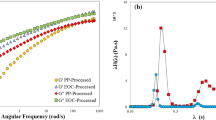Abstract
One of the key factors to a better understanding of the phase morphology of high-impact ethylene–propylene (EP) copolymers is the knowledge of the rheological behaviour of the various phases in these complex systems. Next to the molecular weight distribution, the comonomer content also affects the viscosity, as could be demonstrated in a systematic study of a wide range of compositions. More specifically, this means that for a given average molecular weight, the zero shear viscosity of the disperse phase consisting of amorphous ethylene–propylene ‘rubber’ (EPR) and crystalline polyethylene (PE) of such an impact copolymer are up to orders of magnitude higher than the respective polypropylene (PP) phase. This has a significant effect on the phase morphology and ultimately the mechanical performance of these compositions.









Similar content being viewed by others
References
Bernreitner K, Neizl W, Gahleitner M (1992) Correlations between molecular structure and rheological behaviour of polypropylene. Polym Test 11:89
Bremner T, Rudin A, Cook DG (1990) Melt flow index values and molecular weight distributions of commercial thermoplastics. J Appl Polym Sci 41:1617
Carrot C, Revenu P, Guillet J (1996) Rheological behavior of degraded polypropylene melts: from MWD to dynamic moduli. J Appl Polym Sci 61:1887
Danesi S, Porter RS (1978) Blends of isotactic polypropylene and ethylene–propylene rubbers: rheology, morphology and mechanics. Polymer 19:448
D’Orazio L, Mancarella C, Martuscelli E, Polato F (1991) Polypropylene/ethylene–co-propylene blends: influence of molecular structure and composition of EPR on melt rheology, morphology and impact properties of injection-moulded samples. Polymer 32:1186
D’Orazio L, Mancarella C, Martuscelli E, Sticotti G, Massari P (1993) Melt rheology, phase structure and impact properties of injection-moulded samples of isotactic polypropylene/ethylene–propylene copolymer (iPP/EPR) blends: influence of molecular structure of EPR copolymers. Polymer 34:3671
D’Orazio L, Cecchin G (2001) Isotactic polypropylene/ethylene–co-propylene blends: effects of composition on rheology, morphology and properties of injection-moulded samples. Polymer 42:2675
Eckstein A, Friedrich C, Lobbrecht A, Spitz R, Mühlhaupt R (1997) Comparison of the viscoelastic properties of syndio- and isotactic polypropylenes. Acta Polym 48:41
Fetters LJ, Lohse DJ, Richter D, Witten TA, Zirkel A (1994) Connection between polymer molecular weight, density, chain dimensions and melt viscoelastic properties. Macromolecules 27:4639
Fetters LJ, Lohse DJ, García-Franco CA, Brant P, Richter D (2002) Prediction of melt state poly(α-olefin) rheological properties: the unsuspected role of the average molecular weight per backbone bond. Macromolecules 35:10096
Gahleitner M, Sobczak R (1989) Significance of the zero shear viscosity determination for the modelling of flow curves. Kunststoffe 79:1213
Gahleitner M, Knogler B, Pirgov W, Hafner N (2000) Molar mass effects on the shear creep behaviour of polypropylene. In: Proc of XIIIth International Conference on Rheology, Cambridge, UK, August 2000, pp 1-121–1-123
Gahleitner M (2001) Melt rheology of polyolefins. Prog Pol Sci 26:895
Gahleitner M, Hauer A, Bernreitner K, Ingolic E (2002) Polypropylene-based model compounds as tools for the development of high-impact ethylene–propylene copolymers. Int Polym Process 17:318
Galli P, Haylock JC (1992) Advances in Ziegler–Natta polymerization—unique polyolefin copolymers, alloys and blends made directly in the reactor. Macromol Symp 63:19
Garcia-Franco C, Harrington BA, Lohse DJ (2006) Effect of short-chain branching on the rheology of polyolefins. Macromolecules 39:2710
Gleizle W (1994) Influence of the viscoelastic functions on the melt index. Rheology 3:138
Grein C, Bernreitner K, Hauer A, Gahleitner M, Neizl W (2003) Impact modified isotatic polypropylene with controlled rubber intrinsic viscosities: some new aspects about morphology and fracture. J Appl Polym Sci 87:1702
Grein C, Bernreitner K, Gahleitner M (2004) Potential and limits of dynamic mechanical analysis as a tool for fracture resistance evaluation of isotactic polypropylenes and their polyolefin blends. J Appl Polym Sci 93:1854
Hieber CA, Chiang HH (1992) Shear-rate-dependence modeling of polymer melt viscosity. Polym Eng Sci 32:931
Kim GM, Michler GH, Gahleitner M, Fiebig J (1996) Relationship between morphology and micromechanical toughening mechanisms in modified polypropylenes. J Appl Polym Sci 60:1391
Minale M, Modenaers P, Mewis J (1998) Effect of shear history on the morphology of immiscible polymer blends. Macromolecules 30:5470
Minoshima W, White JL, Spruiell JE (1980) Experimental investigation of the influence of molecular weight distribution on the rheological properties of polypropylene melts. Polym Eng Sci 20:1166
Nomura T, Nishio T, Iwanami K, Yokomizo K, Kitano K, Toki S (1995) Characterization of microstructure and fracture behavior of polypropylene/elastomer blends containing small crystal in elastomeric phase. J Appl Polym Sci 55:1307
Pölt P, Ingolic E, Gahleitner M, Bernreitner K, Geymayer W (2000) Characterization of modified polypropylene by scanning electron microscopy. J Appl Polym Sci 78:1152
Tzoganakis C, Vlachopoulous J, Hamielec AE (1989) Effect of molecular weight distribution on the rheological and mechanical properties of polypropylene. Polym Eng Sci 29:309
Van der Wal AJ, Verheul AJJ, Gaymans RJ (1999) Polypropylene-rubber blends: 4. The effect of the rubber particle size on the fracture behaviour at low and high test speed. Polymer 40:6057
Wapperom P, Keunings R (2000) Simulation of linear polymer melts in transient complex flow. J Non-Newton Fluid Mech 95:67
Yokoyama Y, Ricco T (1997) Crystallization and morphology of reactor-made blends of isotactic polypropylene and ethylene–propylene rubber. J Appl Polym Sci 66:1007
Acknowledgements
The authors want to thank Arild Follestad of Borealis AS in Bamble, Norway for providing the rheological and MWD data for the PE homopolymers and Gerald Rohaczek in charge of the pilot plant in Schwechat, Austria for producing all investigated materials. This study would not have been possible without the valuable support of Jens Reussner and the staff of the analytical laboratory at Borealis in Linz, Austria in fractionating the copolymers. Finally, special thanks to Elisabeth Ingolic of the Centre of Electron Microscopy Graz, Austria for the excellent TEM images.
Author information
Authors and Affiliations
Corresponding author
Rights and permissions
About this article
Cite this article
Grein, C., Gahleitner, M., Knogler, B. et al. Melt viscosity effects in ethylene–propylene copolymers. Rheol Acta 46, 1083–1089 (2007). https://doi.org/10.1007/s00397-007-0200-0
Received:
Accepted:
Published:
Issue Date:
DOI: https://doi.org/10.1007/s00397-007-0200-0




